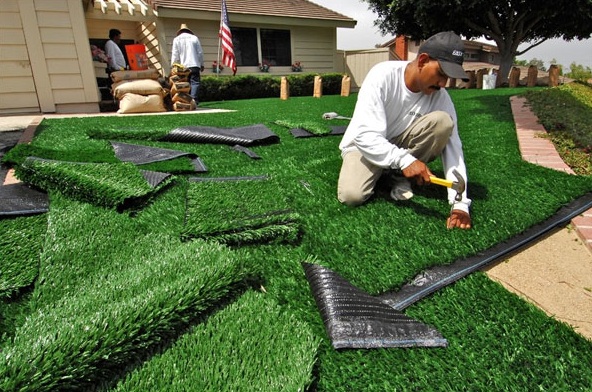Delve Into the Environmental Advantages of Opting for Artificial Turf Solutions
The adoption of artificial lawn services offers a compelling chance to attend to pressing ecological obstacles. By substantially reducing water use and minimizing the application of harmful chemicals, these options not just promote sustainable landscape design but additionally protect regional ecosystems.
Water Preservation Advantages
One of one of the most considerable benefits of synthetic grass is its capacity to preserve water. Traditional lawn yards need significant irrigation, particularly in locations susceptible to dry spell or water limitations. In contrast, synthetic grass does not need watering, considerably minimizing the total need for water resources. This feature is especially helpful in deserts where water scarcity is a pushing problem.
By removing the demand for regular watering, synthetic grass adds to sustainable landscape methods and aids reduce the ecological effect of too much water consumption. In addition, the conservation of water reaches the reduction of runoff, which can cause soil disintegration and waterway pollution.
Furthermore, the installment of synthetic grass permits municipalities and home owners to assign water resources much more successfully, concentrating on important usages such as alcohol consumption water and farming. The shift in the direction of synthetic grass not just promotes liable water use yet additionally aligns with broader environmental goals intended at preserving natural deposits.
As areas increasingly prioritize sustainability, the water preservation advantages of man-made grass offer an engaging situation for its adoption in residential and commercial landscape design tasks.
Reduced Chemical Usage
The change to synthetic grass considerably lowers the reliance on chemical treatments frequently made use of in all-natural grass upkeep. Traditional lawn administration generally involves the application of chemicals, herbicides, and plant foods to advertise growth and control parasites. These chemicals can pose dangers to human wellness, regional wild animals, and the setting, adding to dirt and water contamination.
In comparison, artificial turf gets rid of the demand for these unsafe compounds. By reducing the launch of synthetic substances into the ecosystem, fabricated grass promotes much healthier soil and water systems.
In addition, the lack of chemical overflow associated with synthetic grass setups aids shield regional waterways from pollution, sustaining aquatic life and maintaining biodiversity. Arizona artificial turf. As areas progressively prioritize lasting methods, choosing synthetic grass provides a sensible service that aligns with ecological conservation goals. With this change, residential property owners can enjoy lush green rooms without endangering ecological health and wellness, leading the way for a much more sustainable future
Lower Carbon Impact

In addition, the installment of fabricated grass can lead to substantial water preservation. Natural grass call for substantial amounts of water for irrigation, which not his explanation only includes in the carbon impact associated with water extraction and therapy however likewise strains local water sources. In comparison, synthetic grass needs very little maintenance, requiring no watering, thus dramatically minimizing water usage and its connected power costs.
Furthermore, the longevity of synthetic grass adds to its lower carbon impact. With a lifespan of as much as 15 years or more, the need for frequent substitutes is decreased, causing less waste and lower power intake in manufacturing and dealing with traditional yard alternatives. Generally, man-made grass provides a sustainable choice for ecologically aware landscaping.
Environment Preservation
Habitat preservation is an important factor to consider in the argument over landscaping options, particularly when comparing synthetic grass to natural turf. Natural grass lawns typically need extensive maintenance, including making use of herbicides, plant foods, and chemicals, which can adversely affect local ecological communities. These chemicals can seep into the dirt and waterways, harming native plants and fauna and disrupting local habitats.
Fabricated grass removes the demand for harmful chemicals, consequently protecting neighboring wild animals and preserving the stability of surrounding ecological communities. The installation of artificial grass can lead to the conversion of former lawn locations right into more biodiverse landscapes, such as pollinator gardens or native plant locations, which can support regional wild animals.
Ultimately, the shift to synthetic grass not only saves this article water and decreases maintenance initiatives but additionally promotes a much more harmonious relationship in between human activities and the native environment, promoting environment conservation in the procedure.
Long-Term Sustainability
Lasting sustainability is a crucial factor in assessing the benefits of synthetic grass over typical turf yards. One of the most significant benefits of synthetic grass is its resilience; it can last as much as 15-20 years with very little upkeep, whereas all-natural yard needs regular reseeding and substitute. This long life decreases the need for consistent resources, such as water, fertilizers, and pesticides, which are important for keeping a healthy and balanced turf yard.
Additionally, synthetic grass adds to a decrease in carbon emissions connected with grass care tools. Standard yards often call for gas-powered mowers, leaners, and blowers, every one of which add to air pollution. Arizona artificial turf. In comparison, artificial grass removes the need for such devices, advertising a cleaner atmosphere
Moreover, the manufacturing of man-made grass progressively utilizes recycled products, boosting its sustainability account. As makers embrace environmentally friendly practices, the environmental footprint of synthetic grass remains to decrease.

Verdict
The adoption of synthetic grass services presents significant ecological benefits, including substantial water conservation, decreased dependence on damaging chemicals, and a lower carbon impact. Artificial turf aids in preserving all-natural environments by decreasing land disruption and promoting lasting sustainability via the use of sturdy products. Jointly, these elements highlight the potential of fabricated turf to add positively to environmental health and wellness and use a practical choice to typical landscaping practices in a significantly resource-conscious world.
In comparison, artificial grass does not require watering, considerably lowering the total need for water resources. By decreasing the launch of artificial substances into the ecosystem, man-made grass promotes healthier soil and water systems.
In addition, the setup of synthetic check this grass can result in significant water preservation. In comparison, artificial turf needs minimal maintenance, needing no watering, therefore dramatically decreasing water use and its linked power costs.
